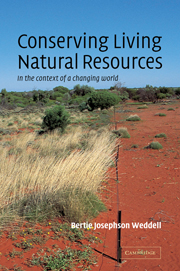Book contents
- Frontmatter
- Contents
- Preface
- Introduction: Balance and flux
- Methodology: Getting the information we need to manage living natural resources
- Part I Management to maximize production of featured species – a utilitarian approach to conservation
- Part II Protection and restoration of populations and habitats – a preservationist approach to conservation
- Part III Management to maintain processes and structures – a sustainable-ecosystem approach to conservation
- Postscript
- Appendix: Scientific names of organisms mentioned in the text
- Index
Methodology: Getting the information we need to manage living natural resources
Published online by Cambridge University Press: 05 June 2012
- Frontmatter
- Contents
- Preface
- Introduction: Balance and flux
- Methodology: Getting the information we need to manage living natural resources
- Part I Management to maximize production of featured species – a utilitarian approach to conservation
- Part II Protection and restoration of populations and habitats – a preservationist approach to conservation
- Part III Management to maintain processes and structures – a sustainable-ecosystem approach to conservation
- Postscript
- Appendix: Scientific names of organisms mentioned in the text
- Index
Summary
The scientific method
Resource managers need scientific information on which to base their decisions about conservation. The scientific method is a mode of inquiry in which testable propositions, termed hypotheses, are formulated and information is gathered to test them. The investigator makes predictions about what will happen under certain circumstances if a particular hypothesis is true and then determines whether or not those predictions are fulfilled. If the predictions are not fulfilled, the hypothesis is falsified.
Controlled experiments
There are many ways to test hypotheses. One is through a controlled experiment, in which a scientist compares a test group with a control group. Controlled experiments are not the only way to do science, however. The real world is more complex than the laboratory. It does not always lend itself to and sometimes it cannot tolerate experimental manipulation. I will return to this point below, but first, let us consider how controlled experiments can be used to provide the sorts of information resource managers need.
- Type
- Chapter
- Information
- Conserving Living Natural ResourcesIn the Context of a Changing World, pp. 9 - 26Publisher: Cambridge University PressPrint publication year: 2002



